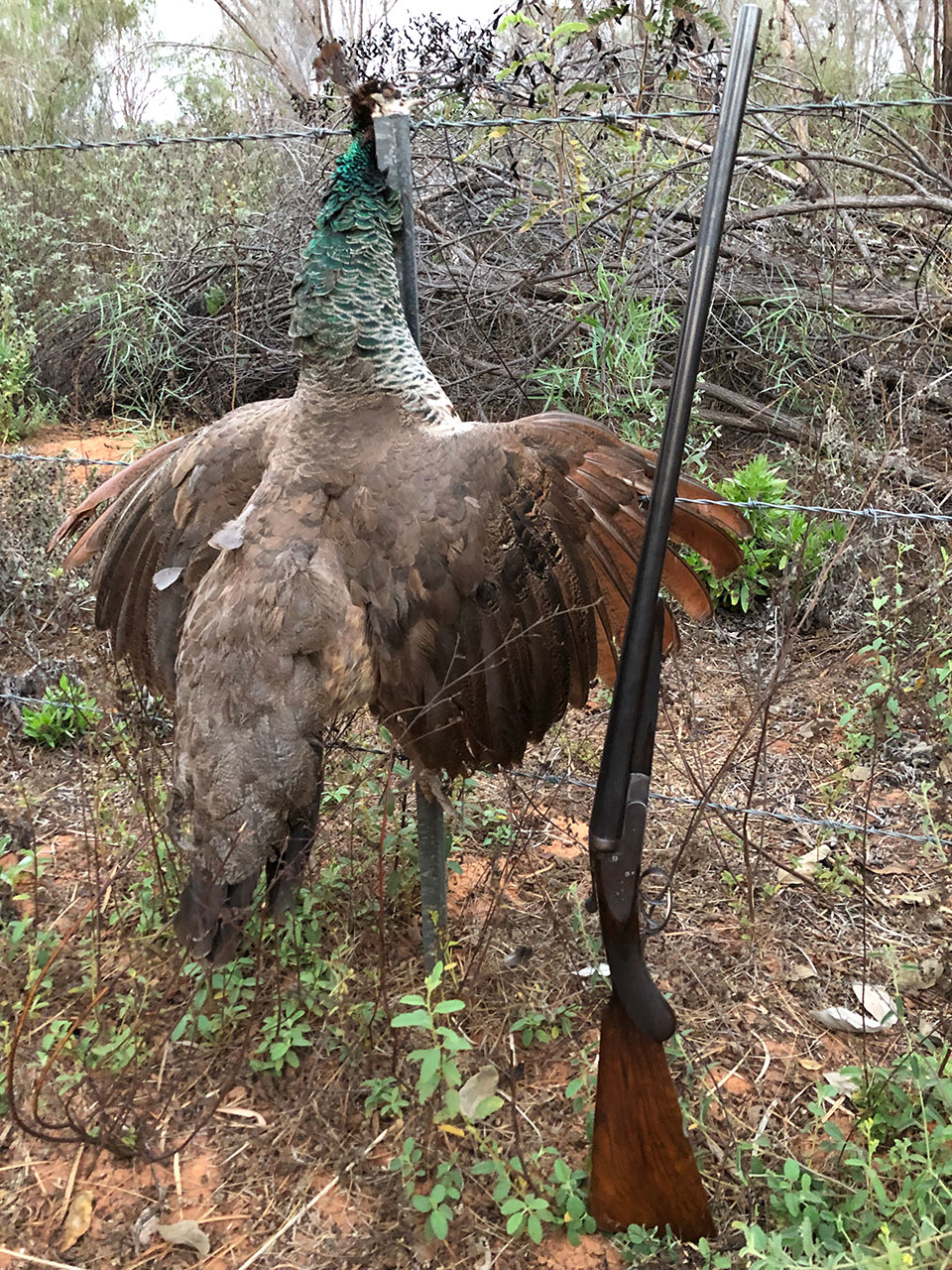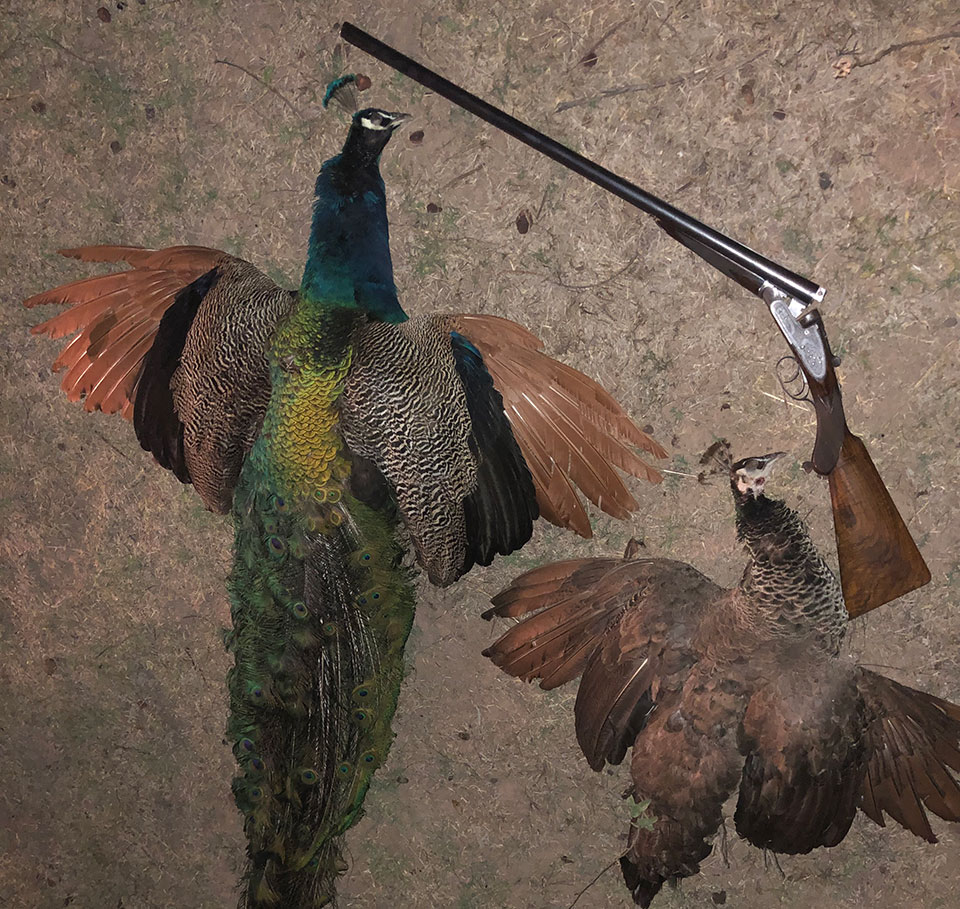Sometimes our hunting ambitions or goals are determined by impressionable experiences of our childhood, anyway that's been my experience.
Going back to my youthful years, I was fascinated listening to the stories of an older man, Michael Morkum, known affectionately as "Morky." Morky had spent time in India just before Independence and enjoyed hunting there, mostly with a 12 bore shotgun, which drew me!
Morky told me stories of hunting Peacocks as a table bird, and of dispatching a number of Leopards which used to kill their dogs to eat.
So, Morky had a pretty interesting history with a 12 bore shotgun; Peacocks, Pigs & Leopards in India with a Tiger kill thrown in!
Many years later, from the 1960's and Morky's departure to hunter's heaven, I finally had a chance to hunt Peacock on Flinders Island, in 2004.
Our notorious guide on Flinders Island was "Rockjaw"; famed for not being able to be knocked out in a fist fight and a very knowledgeable man. I was there primarily to hunt 'Cape Barren Geese' for the first time, having shot several thousand 'Magpie Geese' in the Northern Territory but I was always a mixed bag hunter, looking for extra opportunities to bag other species of interest and peacocks drew me in magnetically!
After shooting a couple of Cape Barren Geese, I negotiated to be dropped off at a location holding a flock of peacocks. He warned me that the locals shoot them out past 100 meters with a 22 Hornet, so Rockjaw and the crew didn't expect me to be successful.
I did successfully shoot a nice male peacock with full plumage, dressed out for mounting and the body went to 'Hunters & Gatherers' feast!
Fast track to 2023 and I had the opportunity to hunt Peacock again after seeking permission to hunt a wild colony on the mainland.
Having achieved legal access, I drove onto the property early afternoon to scope out the area I wanted to hunt in the late afternoon.
I chose to use my 'Walter Betts' SLE with 3" chambers, a dated shotgun possibly made for the rigors of live bird shooting early 20th century.

Doing research on pheasants earlier in 2023, I found out that peacocks were classified as belonging to the pheasant family, more alluring!
As I knew from a hand drawn map roughly where the water was, I parked my Toyota troopcarrier well back to prepare to stalk into the water point. I had a piece of fruit and a drink before unpacking my shotgun and preparing my daypack, departing shortly after along the treeline edge.
There were numerous birds around the water with quite a few cattle, so I moved out of the treeline just enough for the cattle to see me and move off. The Brolga's moved out also, followed by the numerous Ibis, leaving plovers and pigeons still flocking at the edges.
I could see a dark stand of woods funneling away to the south of the primary water source and carefully stalked towards this darker wood.
I saw movement going from the water area to the left through the dark wood, and moved forwards quickly to reduce the range before peahens passed!
I took a shot at the second peahen and bagged her
They were scurrying and can move surprisingly fast along the ground, with a slight lead I took a shot at the second peahen and bagged her with BB's. There weren't any peacocks (males) in this group, but a peahen was better than nothing as the saying, "a bird in the hand is worth two in the bush."
I set the peahen up and took photo's with my phone, then commenced plucking and dressing out this very fat and healthy bird, the shade was handy. When finished, I walked back to the watering area and washed the bird in the clear water, then onto the Toyota & packed the peahen into esky.
The allure of a regal Peacock still was not realised, so I decided to move out of the area by Toyota & explore the surrounding country via road. I came across a couple of peahens feeding through the brush only 100 meters from the highway, totally unperturbed, walking across the track. Leaving the Toyota running, I quickly retrieved my gun and stalked into the bush at an angle to intercept them, which I accomplished without spooking them.
I contemplated shooting both of them, but with limited space in a relatively small esky I elected to pass on them leaving them undisturbed.
By now the afternoon shadows were growing and the sun started to dip quite fast, so I drove to a new area in the hope of the desired peacock.

Starting to have some misgivings at passing up two easy peahens I noticed some peahens from the highway feeding in a drain off the highway. Keeping driving until well past I entered the property again to stalk back along the fenceline, believing I'd have the element of surprise, Wrong!
As I carefully stalked through the bush edge I noticed movement to my right on the firebreak, the peahens were running down the firebreak.
I snapped a shot and more by luck than good management, through congested brush and barbed wire fence bagged the Peahen!
Still no Peacock, but two peahens in the bag and light fading fast, I was reconciling myself to a night in the swag under the stars to hunt the morrow.
Took photographs and walked along the firebreak to the road a short distance away where I'd parked the Toyota to enable the stalk.
Had a drink and piece of fruit and had hardly started to pluck, when my nemisis, a peacock started calling from what appeared only 200 meters away!
I knew from my 2004 Peacock hunt at Flinders Island that they roost high and call in the evenings, they seem to have this wired into their DNA! Knowing the call, I had to give it a go, so gathering the Betts with some spare cartridges I started moving in, the closer I got it seemed further away.
gathering the Betts with some spare cartridges I started moving
I finally realised I was on the wrong side of the cattle fence and quietly put the gun on the ground and climbed through slowly not to twang the wires. Even now, this cock bird seemed to be in the next big tree, but careful skylining proved it empty, careful stalk to the next big tree, and the same result.
I could tell I was very close after stalking about eight trees inline with his raucous calling, eventually he was silhouetted against the sky.
As I didn't want to move, i took the shot but for no result. Realising I had shot through his tail, I moved to the left and with a clearer silhouette view, shot again.
This time the cock bird took off with an incredible racket of calls and rapid wing beating; he flew out of sight within ten meters, keeping going.
Listening as intently as I could to these few microseconds of rapid wing beating., I heard him crash into a tree, followed by a resounding Thud! I felt confident that the thud was the result of a deadfall, and not the wounded crash landing of an injured bird still able to run and escape.
Searching the ground carefully up to the fence didn't reveal the desired cock bird, the peacock, so I parked the Betts against the fence for my return. Walking down the roadway to the Toyota I reminded myself that I've heard that deadfall thud hundreds of times on Magpie Geese in the N.T.
Putting the peahen into Toyota, I drove along the road to the Betts marking point, then, using a spotlight, it took only one sweep of the bush to illuminate the bird. There, stone dead lay my second peacock and I felt as elated as if I'd shot a great stag or the like; the beauty of these birds is something to behold.

More photo's with the mobile and I set about plucking and dressing out both hen and cock birds, now the esky was full and the hunt truly COMPLETED!
The following month I hosted an Aboriginal family for dinner and cooked the cock bird. The visitors were very impressed with the fare!
My friend's wife plucked up the courage and asked for the feathers on the table, her wish was granted and they went to an appreciative home.
Published by Vintage Guns Ltd on



